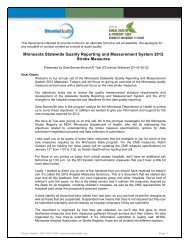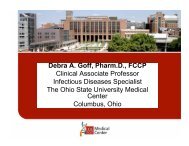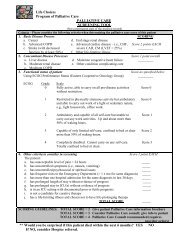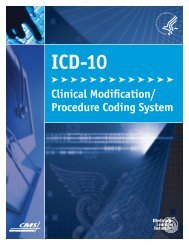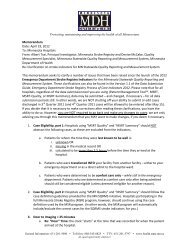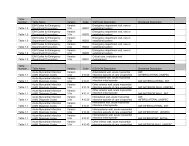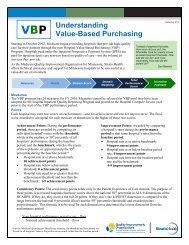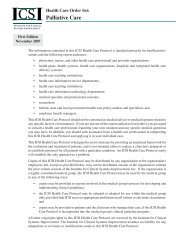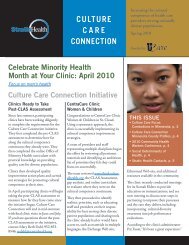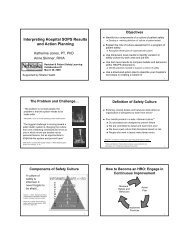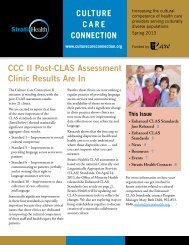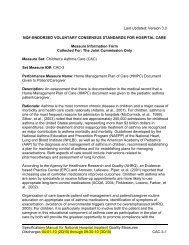Webinar Transcript Template - Stratis Health
Webinar Transcript Template - Stratis Health
Webinar Transcript Template - Stratis Health
You also want an ePaper? Increase the reach of your titles
YUMPU automatically turns print PDFs into web optimized ePapers that Google loves.
This transcript is intended to provide content in an alternate format to aid accessibility. We apologize for any<br />
inaudible or unclear content as a result of audio quality.<br />
“Learning and Action Network:<br />
An Introduction and Addressing Issues with Quality Reporting<br />
Presented Dr. Paul Kleeberg; Clinical Director, REACH, Phil Deering; Regional<br />
Coordinator, REACH, Connie Geyer, North Dakota <strong>Health</strong>care Review Inc., and Jerri<br />
Hiniker, <strong>Stratis</strong> <strong>Health</strong>.<br />
(53-minute <strong>Webinar</strong>) 02-29-2012<br />
Jerri Hiniker: Welcome everyone to our first education session webinar, part of the<br />
Learning and Action Network. Today we’re going to be doing an introduction and<br />
addressing issues with quality reporting. I appreciate everybody signing on in the late<br />
afternoon.<br />
Today, our presenters will be Dr. Paul Kleeberg, the Clinical Director at REACH the<br />
regional extension center, and Phil Deering, who is Regional Coordinator, also with<br />
REACH. Connie Geyer, who is a quality improvement specialist with the North Dakota<br />
<strong>Health</strong>care Review Inc., and then myself (with <strong>Stratis</strong> <strong>Health</strong>, the quality improvement<br />
organization for Minnesota).<br />
In our agenda for today, we’re going to start with an overview of the Learning and Action<br />
Network. Then we’ll do an overview of quality reporting for meaningful use, which will be<br />
followed by an introduction to using a new quality reporting system.<br />
Connie and I will start with an overview of the Learning and Action Network. Many of you<br />
may have the question ―What is the Learning and Action Network?‖ You’ve all received<br />
invitations over the past few months inviting you to become part of this learning and<br />
action network, which is a collaborative between REACH and the Minnesota and North<br />
Dakota Quality Improvement Organizations.<br />
The Learning and Action Network stems from the partnership, actually, that came out of<br />
the work for the Quality Improvement organization, work that we’re doing as part of CMS<br />
that we’re contracted to do. What the work was looking at was helping with those clinics<br />
and providers who have already reached Milestone Two, and working with them in the<br />
regional center or REACH to provide further education to those providers and clinics.<br />
A lot of the focus that we’re doing is in a preventive services area. I just want to talk a<br />
little bit more about the prevention project. The focus of this prevention project is<br />
improving help for populations and communities. We started in August of 2011, and it will<br />
run for the next three years, through July 31 of 2014. The specific goal is to provide this<br />
collaborative environment between the QIOs and the regional extension centers and,<br />
Page 1
hopefully, those clinicians who are ready to reach out to welcome the further education<br />
and resources we can offer you to help you optimize your electronic health records.<br />
Many of you on the call have actually probably been part of the work that’s happened<br />
over the last few years with electronic health records at <strong>Stratis</strong> <strong>Health</strong> and what the North<br />
Dakota QIO have been doing as far as helping people get up and running on electronic<br />
health records, but also the preventative services work that we’ve done over the past<br />
three years. This is really an extension of that, while we are looking again at those<br />
preventive service measures, we’ll also be looking at what other measures we can help<br />
you use your electronic health records to the holistic stem.<br />
Connie Geyer: Thanks, Jerri. The Learning and Action Network, like Jerri said, is<br />
relatively a new concept. It’s to help with widespread knowledge, gathering colleagues<br />
from all over the state of North Dakota and with this collaboration, between Minnesota<br />
and North Dakota, to try to share expenses and challenges that we have been facing or<br />
you may have been facing with reporting your quality measures.<br />
It’s a mechanism for fostering large scale improvements. It’s a good way to be able to get<br />
together and share best practices, manage knowledge as a valuable resource, and it<br />
provides opportunities for our communities to harness knowledge, and learn from our<br />
challenges, and share our successes in reporting the quality measures.<br />
Also, many of the meaningful use measures overlap or align some of the other measures<br />
that we will be addressing in the Learning and Action Network. We are actually having<br />
two types of Learning and Action Networks, prevention network which will help offices to<br />
promote prevention services such as influenza immunizations,<br />
pneumococcal vaccinations, making sure we are promoting mammogram screening and<br />
colorectal screening.<br />
Our cardiac Learning and Action Network will focus on some different measures. Those<br />
will include things like managing patients with coronary artery disease or peripheral<br />
vascular disease, making sure their blood pressure is less than 140/90. Patients with high<br />
cholesterol, making sure their cholesterol is less than 100, making sure that patients are<br />
identified as being smokers if they’re receiving smoking cessation counseling. Also, a<br />
patient that has vascular disease, that those patients identified with IVDs that they will<br />
have some type of vascular therapy or antithrombotic therapy under appropriate<br />
conditions.<br />
We also want to promote sustainability and strength. This is something we want to keep<br />
focused on as time goes.<br />
With strategies that we’ll use we’ll be reviewing the educational needs in the clinics. We<br />
understand by talking with several of you that there are a lot of demands. You’re trying to<br />
get your EHRs up and running, trying to pull quality, and you have lots of different things<br />
to report on. By showing you that most of these aims do align, it’s not doing extra work,<br />
it’s just doing the same, sending the reports to other places.<br />
We at the QIOs think we’re a best kept secret that we can come in and help you do that<br />
so that it isn’t any additional burden or frustration on your clinics, because we all<br />
Page 2
understand that there’s limited time that you have to share this information. We want to<br />
provide regular opportunities for collaboration, some of those are listed on your screens.<br />
There are several ways we’ll be doing this throughout the year, we’ll have face-to-face<br />
meetings, webinars like this, and getting together on conference calls. We’ll even do<br />
some online or virtual meetings as well to try to give everyone an opportunity to be able<br />
to share and learn from each other.<br />
We will also be able to go on-site or over the phone, provide technical assistance in<br />
helping you pull this data, helping you to set up your earpieces, how to pull this data,<br />
where to get it from, and how to get these measures reported correctly.<br />
Like I said, we understand your frustrations and we’re here to take some of the frustration<br />
out of this so your quality reporting won’t be quite so burdensome to your practice. We<br />
want to be able to learn from each other, from our successes and challenges, and make<br />
this a sustainable and viable thing for the future. With that being said, I’ll turn it over to<br />
Phil Deering, the Regional Coordinator for REACH.<br />
Phil Deering: Thank you Connie. This morning we’ll take a little time to run through not<br />
the details of quality reporting for eligible professionals to obtaining meaningful use, but<br />
rather some of the issues that have confronted people.<br />
As part of the introduction, I want to say that I know all of us at the regional extension<br />
centers, especially in Minnesota and North Dakota (where a high percentage of providers<br />
in Minnesota aren’t having huge challenges with meeting meaningful use), but we all<br />
know that everyone has challenges with effective use of their EHR. Meaning, using that<br />
technology to make sure that we’re providing better quality, safer care, and, also, running<br />
more efficient operations in our clinics.<br />
This opportunity for the Learning and Action Network allows us at the regional extension<br />
centers to bridge that government bureaucratic requirement for meaningful use to the<br />
effective use that will be able to get at what your patients and providers need.<br />
Like I said, I’m going to do a brief overview of the basics of quality reporting requirements<br />
for meaningful use, and if any of our listeners or participants in the call needs more<br />
information about quality reporting that I don’t touch on, please be sure to contact your<br />
REACH field service consultants. Or, if you’re having trouble figuring out who your<br />
regional service consultants are, get back to any of us on this call and we’ll be able to get<br />
you more details.<br />
Just reviewing the basics of clinical quality measures for meaningful use. First, each<br />
eligible professional– remember, meaningful use is by eligible professional it’s not done<br />
at the clinic level– needs to report on three clinical quality measures from a set of core or<br />
alternate core measures. I won’t go through what those measures are on this call, but at<br />
the bottom of this there is a link to a very good and clear list of those required quality<br />
measures.<br />
In addition to the three core or alternate core, each EP needs to report on three additional<br />
quality measures that come from a list, or sometimes we call it a menu, of 38 clinical<br />
quality measures. The numerators/denominators and exceptions must be those<br />
Page 3
generated by the certified electronic health record technology, which is the key point and<br />
one that often causes people a little confusion. Whether or not you believe those<br />
numbers that are coming out of your certified EHR are correct or not, you need to, in<br />
phase one, report the numbers that appear.<br />
Many of our clients at REACH, when they are confronted with a clinical quality measure<br />
reporting, come to us saying ―Wait, these don’t apply to me. What do I need to do?‖ So,<br />
I’m going to walk through the process, in general, for dealing with the fact that if you<br />
begin to look at core measures what you do. I’ll go through all six steps.<br />
You need to report on three core or alternate core.<br />
If any of the core measures, if your EHR brings those up and you see there is a<br />
denominator of zero so that none of your patients fit the basic requirement to be in that<br />
class, then you need to find alternate core measures where the denominator is not the<br />
zero.<br />
Finally, then you report on all those to get to three where you have a non-zero<br />
denominator. If you have less than three with a non-zero denominator then you have to<br />
report, you have to attest to the fact that all six or all the other six have zero<br />
denominators. Let me walk through with the example of a pediatrician.<br />
If there’s a pediatrician who doesn’t see anyone 13 years or older, it’s clear when you<br />
look at the core and alternate core quality measures that first of all, none of the core<br />
apply because they’re all for adults. Alternate 2 and 3, which are about childhood<br />
immunizations and childhood weight management, do apply. So then the pediatrician<br />
would go ahead and attach to both numerator and denominator and possible exclusions<br />
that are generated by their certified EHR technology. Then finally, they have to go attest<br />
to the other four that they actually have zero in their denominators, because you can’t get<br />
a percentage. In addition, each EP is required to pick three from the list of 38 clinical<br />
quality measures that then apply to them. Again, we’re not going to look through these<br />
but I believe many of you on the call have looked through these, and find that in many<br />
cases you actually have CQMs that your certified EHR technology is certified to report on<br />
and that do apply to your EP.<br />
If your certified EHR technology sometimes, in some cases, will only give you three of the<br />
additional measures. In that case, often none of those apply and then you need to report<br />
zero denominators for all the measures. On the attestation form you will report that I get<br />
zero on all the 38. The EP is not responsible for determining the status of CQM that<br />
certified EHR technology is not capable of calculating.<br />
Dr. Kleeberg: Let me pause you for a moment. It would be clear to have zero in the<br />
denominators for all for which the EHR was pertinent, not all 38.<br />
Phil Deering: Okay. Thank you. That is correct. Basically, you then report those if you<br />
can. If your EHR is capable of reporting all 38 but none of them apply to you, then you do<br />
need to attest for all those that your EHR can generate that you would have zero<br />
denominators. Therefore, the goal is to report six non-zeros or attest to the fact that you<br />
have zero denominators to make up to that six.<br />
Page 4
When this initially came out and our clients started to attest to CQMs, there were a<br />
number of cases where our clients were looking at the numerators and denominators with<br />
the percentages that were being generated. They realized that these were not accurate<br />
reflections of what their patient populations were truly demonstrating or, what would be a<br />
true measure of that quality measure.<br />
When they looked a little deeper they realized that the workflow they were following,<br />
which was absolutely appropriate for their clinic and patients, was not workflow that their<br />
EHR vendor required in order for all the data to be accurately reflected. CMS recognized<br />
this and put out a clarification that right now in stage one, they do not expect clinicians to<br />
change workflows to get data into the EHR so the CQMs accurately reflect what’s going<br />
on in the clinic.<br />
Instead, the law makes it very clear that the requirement is to report percentages that are<br />
generated by the certified EHR technology. So, whether or not those percentages are<br />
accurate you need to report those percentages, and, certainly, don’t change a good<br />
workflow that is working for you and your patients, so as to accommodate an awkward<br />
workflow that is inherent in the EHR technology.<br />
Over time there is clearly an expectation that you would contact your vendor, talk about<br />
this and recommend to your vendor that they develop a better work flow or over time<br />
perhaps you will be able to switch to the workflow that the vendor recommends.<br />
The other question we receive a lot again comes from a change in the requirement and,<br />
initially, when the meaningful US regulations came out it said that clinical quality<br />
measures will be done by attestation, meaning that you go into the attestation site and<br />
put in numerators and denominators, but you don’t transmit that electronically.<br />
However, there was an expectation that in 2012, these measures would be reported<br />
electronically. That is no longer the case. There is potential to sign up for a pilot program<br />
where you would use PQRI or PQRF reporting mechanisms to also report your measures<br />
electronically from your certified EHR technology, but in most cases, most of the EPs that<br />
we’re seeing are just going to stick with the attestation sites. Actually, we haven’t worked<br />
with anybody yet who has joined in the pilot, I don’t believe.<br />
Those are available if somebody is eager to be part of a pilot, please contact REACH and<br />
we will work to see if those pilots are still open. Basically, I think our best guidance is to<br />
stick with what we have already because it’s pretty straightforward.<br />
Some of you have EHR technology that has a vendor with more CQMs available, but the<br />
vendor didn’t pay to get them all tested because they have to pay additional money for<br />
that. CMS has put out an FAQ clarifying this, which is 106.9 and if you believe, if your<br />
vendor has told you yes, we actually have CQM reporting embedded in our technology<br />
it’s just not certified. You can go ahead in phase one and use that and report to those<br />
CQMs. This will only be in the case of additional of those 38, not in the core six which all<br />
certified electronic health record technology must be able to generate.<br />
Page 5
I’m going to invite Dr. Kleeberg to comment on this. All of us are madly looking at the<br />
regulation and it’s another 500 pages without your details, but certainly I know Dr.<br />
Kleeberg and I have looked at some of the tables which you can begin to understand.<br />
The first and, we think best news is…‖We’re committed to aligning quality measurement<br />
and reporting among our programs,” meaning CMS. So, IQR, PQRF, CHIPRA, ACO, all<br />
those things and we know there is a strong effort and the highest levels of the ONC and<br />
CMS understand that this is not acceptable and are moving towards normalizing it and<br />
bringing all these measures together so there can be more straightforward reporting.<br />
Second, my understanding in looking at it is that in stage two there will be 12 measures<br />
required for each EP to report on, and there’s some question that there will be 12<br />
mandatory or 11 plus 1 menus, which I saw somewhere in the measures. I went through<br />
and tried to read to count, and I came up with 81 new additional measures that were<br />
there. It’s quite a fascinating list, and probably some of you have also looked, but clearly<br />
they are extending it across many specialties.<br />
There were ones on NFG, radiology, a number on dementia care, optometry, mental<br />
health, all sorts of new measures are being added, and I think that’s an important step<br />
forward, to make sure that we’re not just limiting these to the classic primary care quality<br />
measures.<br />
There is no view of in stage two that there will be penalties or incentives paid for reaching<br />
certain percentages of quality measures. There is quite a bit of language in the proposal<br />
for stage two, where there is recommendation that the clinical decision support rules in<br />
the EHR for the EP, than would be aligned with quality measures that those EPs are<br />
trying to obtain.<br />
Again, I think a positive step forward instead of turn on any clinical decision support, but<br />
instead turn on clinical decision support mechanisms that will encourage or push you in<br />
the right direction towards the quality measures you’re trying to obtain. That’s all I have.<br />
Jerri Hiniker: Now we’ll turn it over to Dr. Paul Kleeberg who will be doing an<br />
introduction to using quality reporting.<br />
Dr. Kleeberg: Thank you. To some extent I think I may be preaching to the choir a little,<br />
because I think many folks recognize, at least in Minnesota and North Dakota, that the<br />
only way you’re able to judge the type of care that you’re providing is if you actually<br />
measure what you’re doing.<br />
The interesting thing is if you ask any provider, and this is how it was in my clinic before<br />
we had quality measures, we all believe that we provide care that’s above the average.<br />
We all provide good care.<br />
The question then becomes, if you really want to create change, how do you create<br />
change without actually creating the need?<br />
By looking at quality measures and allowing people to see what they’re doing and how<br />
they’re doing it, it gives them the opportunity to compare themselves with what they think<br />
Page 6
they’re doing, compare themselves with others and also give them some motivation for<br />
change.<br />
We as providers, be we physicians, nurse practitioners, physician assistants, we’re all a<br />
fairly competitive bunch, so when we see we’re not doing as well as we think we should<br />
be we try to strive to do better. Giving us information is something that can help us to<br />
begin to feel the motivation for change within ourselves.<br />
Anyone who has shown their providers quality reports will attest to the fact that one of the<br />
first things that they hear from the providers is, ―My patients are different and these<br />
numbers don’t really reflect the type of care that I’m giving. It’s wrong.‖ There are lots of<br />
gnashing of teeth and hollering, and that is how it was in my clinic when our diabetes<br />
numbers first came out. Interestingly enough, over time the numbers gradually began to<br />
improve and the quality of care gradually improved, which still had people complaining<br />
but it was interesting because they began paying more attention to it.<br />
The next slide is from a clinic up in northern Minnesota. They’ve been on EHR for some<br />
time. They weren’t at meaningful use yet, because their vendor wasn’t really a<br />
meaningful use EHR, at this point in time, so what you’re looking at is a document they<br />
would print every quarter.<br />
Right now you’re looking at the third quarter data for 2010, and these are for patients who<br />
either have high blood pressure and have or don’t have cardio vascular disease. The<br />
ones in red are those that have cardio vascular disease. So if you look under the first<br />
column called organization you’ll see two number 3s. One is red and one is black. The<br />
red number 3 is the third quarter for those with cardio vascular disease and the black 3 is<br />
for those in that third quarter without cardio vascular disease.<br />
What you can see is we’re looking at the organization-wide number. On the top left is 681<br />
patients with cardio vascular disease and hypertension, reported 18 without cardio<br />
vascular disease and hypertension and the next three columns break it down by clinic. In<br />
the last column, you see this one particular provider they’re calling Dr. Blue. I don’t think<br />
he’s blue because he’s holding his breath, he just happens to be called that.<br />
If you look down the left you see, for example, if we go to one LDL less than 100, which is<br />
what’s indicated for patients with hypertension and cardio vascular disease, the<br />
Minnesota State average is 64%. There is no recommendation for Minnesota for those<br />
without cardio vascular disease. Organizationally, the organization is not doing as well as<br />
that of the state average they only have 29%. If you look at clinic one, it’s 32% for those<br />
with cardio vascular disease, clinic two has 21%, clinic three 17%, and clinic four has<br />
45%, still below the average, but significantly above the rest. As you can see, Dr. Blue is<br />
also above the rest in terms of his keeping LDLs below 100 for patients with cardio<br />
vascular disease and hypertension.<br />
This allows a couple things to happen. First, the different clinics can talk to each other<br />
and find out what process they’re using or what each other is doing, so they can begin to<br />
learn new workflows on how this stuff can be accomplished. Also, potentially, Dr. Blue<br />
has the opportunity to say ―Wait, people are doing better in my group like that, maybe I<br />
Page 7
need to talk with some others in my group.‖ Then if you go down the page you can see<br />
they’ve done that.<br />
The third one is LDL no LDL for patients with cardio vascular disease and hypertension.<br />
You can see that organization-wise 22% of the people had no LDL and again, clinic one<br />
was 25%, two was 34%, three is 23%, and again, clinic four seem to be doing better with<br />
6% where there was no LDL on file. Obviously, you want your LDL on file with patients<br />
having cardio vascular disease and high blood pressure.<br />
So, again, this is an example of how you can look across the clinics and prepare the two.<br />
Let me draw your attention to just one more. The very last one: no aspirin documented.<br />
Again, most people seem to have either the fact that they’re on aspirin or they aren’t or<br />
they have a reason for not being on aspirin. We have 6% for those (organization-wise),<br />
2% for clinic one, 7% for two, 14% for three, and 4% for four.<br />
Just looking at these numbers briefly you can see there’s a bit of a difference between<br />
clinics three and four, and given this analysis there is some good opportunity for clinic<br />
three to potentially learn from clinic four. How could you do this without the data?<br />
The next line is, over time for the first three quarters for the 2010, and this is patients who<br />
are tracked with their PF29 (their depression screens). If you look, the bottom line is the<br />
total patients who have depression, and you can see, organization-wise, it’s 484, 479,<br />
423, declining a little bit. Depression declines a little through the summer and into fall,<br />
which is good. But by fourth quarter it’s back up again.<br />
If you look at the percentages of PF29s that were accomplished, again you see 36, 42,<br />
49 organization-wide, so maybe just by looking at it they’re actually beginning to pay<br />
attention to it and do it more. You see the trend and clinic one goes from 34 to 44 and 54,<br />
clinic two 19 to 31 and 36, clinic three had a little bump 52, 63 and 47, and clinic four 40<br />
to 56 and 72. Again, you can see a trend going in an upward direction by and large,<br />
except for the blip on clinic three. So again if you begin measuring things and pay<br />
attention to things, you can begin to achieve your goals and objectives, consequently<br />
improving the care for the patients you’re seeing.<br />
The other thing that quality reports allow you to do is it allows you to drill down to find<br />
those people who have fallen through the cracks. As a provider, before an EHR, before<br />
running reports you could say I ordered A1Cs on every one of my diabetics that come to<br />
see me. The question is, what about the ones that don’t come to see you? Those are the<br />
people that sometimes may forget or miss their appointments. They need a reminder to<br />
come back in.<br />
So if you look at the next slide you can see these are diabetic patients with a diabetic<br />
report for a particular physician, and if you look at the fourth line is someone who hasn’t<br />
had an LDL done in a while, they haven’t had an A1C and their blood pressure is 164/82,<br />
not good. That would be someone you might want to call to say ―Hey, we’d like you to<br />
come in for appointment. You haven’t been in for a while and we want to make sure<br />
you’re doing okay.‖<br />
You can also see that there are some here doing very well and I’m surprised to see an<br />
LDL at 42. That’s awesome! There are a couple others very similar, so by and large this<br />
Page 8
panel is looking very good with blood pressures below 120 on many and that they’re on<br />
aspirin. Again, there are a lot of opportunities to see what’s missing, to call in the patients<br />
that need to be seen and you can better manage your entire panel. This is one way you<br />
can manage population, by reaching out to individuals and having them come in for care.<br />
So, those particular reports, the way they were accomplished is that a group of clinics got<br />
together and hired a part-time person to write the reports within their EHR. There is the<br />
opportunity to do that if you’re sharing a platform with someone else. You could<br />
potentially get grouped together, try to figure out how you can get the reports you want<br />
out of your EHR and begin to write those reports. That’s one methodology and that<br />
worked rather well for that clinic.<br />
Another methodology could be to use the current meaningful use reports that you have in<br />
your EHR that Phil was talking about. There are two reports you can see, one is on the<br />
criteria which are the engines that feed the quality report. You aren’t going to know about<br />
your patients and whether or not they’ve had an A1C drawn if they’re diabetic if you don’t<br />
have diabetes on the problem list. You won’t know if they’re hypertensive and see if their<br />
blood pressure is right without hypertension on the problem list.<br />
So again, you want to track to make sure, these are rudimentary right now because all it<br />
is looking at is to see if there’s one problem on the problem list, but at least it’s a start and<br />
you can begin to identify people that need help in completing the EHR.<br />
Then, when you look at the quality measures you can see places that aren’t going to be<br />
100% accurate, but a good EHR will allow you to drill down on your quality measure to<br />
see who you’re missing. So again, you can begin to approach them and find out if they<br />
want to come into the clinic because they need some particular values and elements<br />
done.<br />
This is another way that you can leverage those calling measures that are installed within<br />
your certified EHR technology.<br />
Those are two ways you can begin to use your quality reporting:<br />
1. Potentially have someone build some of the quality reports for you and hire someone<br />
to build and share it with your groups<br />
2. Begin to identify the quality reports within your EHR, and begin to drill down into them<br />
to make sure the problem lists and medication lists, etc., are filled out, and that people<br />
are working well in keeping, completing, and doing work on their quality measures<br />
Finally, how do you go about doing this?<br />
You don’t want to all of a sudden do this bang, because it’ll be a big surprise, there’ll be<br />
some concerns and maybe the numbers aren’t accurate. The best way I would suggest<br />
you approach it would be for you to run the numbers yourselves a few times. Look at the<br />
data, drill down, and see if it begins to make sense using the reports for the meaningful<br />
use or if you’re able to have some of the ones you’ve had built.<br />
Page 9
Once you’re pretty satisfied that they look okay then I would share them with the group as<br />
a whole. Show the data for the clinic as a whole and then show the data for each<br />
individual, but hide who is who, so you don’t know who is getting what numbers. Give the<br />
provider the key so they know where they fit on that chart. Allow that to run a few times,<br />
and give them some opportunity to modify their numbers to improve, because they will<br />
make some changes when it’s anonymous.<br />
Then, finally, and set a date for when this happens, have those numbers be absolutely<br />
public to the other staff and providers within the clinic. Again, that allows them to find out<br />
who’s doing well. And rather than to be something judgmental, they can go to another<br />
person and say what are you and your nurse doing? How are you making this work so<br />
well? Help me understand, because that’s the best way to be able to share knowledge<br />
and improve things if other people can see whose succeeding and who may need some<br />
help.<br />
Eventually, they’ll probably be revealing these numbers to the world at large, so it would<br />
be better for us to begin this from working not only internally but also externally. To<br />
reiterate what Phil said earlier, the current cloning measures within the EHRs you’re still<br />
not rated on the numbers. That will be true for stage one, so even if you have horrible<br />
quality measures it won’t matter because it’s not published.<br />
Stage two, the proposal is that it would be the same. They don’t expect to rate you on<br />
your numbers and they aren’t expecting to publish them. That’s not true for stage three.<br />
For stage three there will be expectations of improved quality, and I think by that point in<br />
time it will be revealed. So, again, better to start now to become comfortable with<br />
measuring quality, comfortable with processes to improve quality, while you can do it in<br />
the privacy of your own clinic before revealing it to the world at large.<br />
With that, I think I will close and open up for any discussion and questions.<br />
Jerri Hiniker: We sent out discussion questions earlier, but also I would make sure if<br />
people have questions for Dr. Kleeberg or Phil they should feel free to ask those while<br />
we’re here.<br />
Dr. Kleeberg: One of the questions I have for the people on the call is this: ―I’m curious<br />
to know how many are ready to do quality measure stuff like this and how many out there<br />
have actually found some success and have been able to move the bar, as a result, of<br />
using quality measures?‖<br />
Phil Deering: Jerri, you can pull up to see if anyone might be willing to speak up.<br />
Jerri Hiniker: One of the things we’re wondering in fact is this. It’s your time to share<br />
lessons learned with other clinics or find out from other clinics and providers what they’re<br />
doing, so if any of you out there have done some quality reporting or have seen how<br />
using a quality report can show improvement, we’d appreciate you sharing that<br />
information.<br />
Guest: Not as much a question but a response to the question asked. We do have some<br />
issues with some of our quality reporting, but what we’re really focusing on is making<br />
Page 10
sure that our measures are accurate that are being pulled from our EHRs so that they’re<br />
meaningful for our providers. We’re benchmarking ourselves off those measures and<br />
trying to improve our overall processes to continue to improve those measures. The other<br />
thing that’s a little bit of a frustration for us is that we report several measures that aren’t<br />
all identical and so the EHR is only going to pull certain data for us. We’re trying to use<br />
some business object report mechanisms to report the different types of data that we<br />
have to report for different entities.<br />
Phil Deering: That frustration is just really widespread, especially in Minnesota and<br />
North Dakota. For Minnesota, for example, providers are required to do a set of<br />
Minnesota Community Measurement Reports, some of which are a little tick off of the<br />
meaningful use report. And then, in addition, many of the payers are requiring another set<br />
of quality measures be given to them, which are a third tick off of what the other two<br />
were. So it’s important that those of us working with this push for rationalization and<br />
normalization, and best practice, so that this improves.<br />
Guest: I was just going to say this is my first year with getting involved with quality<br />
reporting and what we have found, when you talk about data extraction from the EHR, is,<br />
boy, that we have lots of work to do there! Getting sure you’re capturing your data<br />
appropriately. I think once we get it electronically, this will be quite a snap to pull that<br />
data. This manual extraction was really a crazy thing for us last year, which was the first<br />
year, so we did learn a little bit from that as far as our electronic medical record goes. We<br />
were able to make some changes from last year which helped us this year. You talk<br />
about the quality piece of it, but also improving your electronic health record goes in<br />
tandem with each other.<br />
Phil Deering: Initially, were you being required to have providers to suddenly go three<br />
screens over and then click a box or those sorts of things that would cause resistance in<br />
their workflow? Or even, were other users having to come into a process that was being<br />
done by the roomer, but suddenly the EHR wasn’t picking that up unless it was done by<br />
the MD? Did you run into any of those situations?<br />
Guest: We ran into situations where we actually had to create fields and then put those<br />
fields in and try to develop them in their workflow of their electronic form. We had to<br />
customize and tweak things. It did make a change and continue to make changes in their<br />
workflow and processes.<br />
Dr. Kleeberg: That’s an interesting point you make, because I think those of us who<br />
have been using the EHR for some period of time, have created all those custom dated<br />
capture mechanisms to be able to measure diabetes care, hypertension, and all those<br />
things accurately. And then– those techniques haven’t turned out to be the same spots<br />
that– to try and collect that information. I know ONC in their new standards and<br />
certification criteria for EHRs is aware of that issue and wants to begin to repair that<br />
damage in the next go round of EHR certification.<br />
For right now, it’s still what’s slowing many people down who have established EHRs,<br />
because now providers are saying you want me to document this where. As Phil was<br />
saying earlier, it’s not in the workflow so they’re not documenting it and the numbers don’t<br />
seem accurate.<br />
Page 11
Guest: Yes, and it’s not that they don’t want to do their jobs or capture the status, it just<br />
slows them down so much, they become frustrated with it.<br />
Phil Deering: Thank you those comments are very helpful.<br />
Guest: Thank you.<br />
Guest: I just wanted to mention that we have not started quality measures or anything,<br />
but it sounds like a lot of people have already done that. We have not, but I do think that<br />
gathering the data abstraction seems to be somewhat of a challenge. We found that on<br />
the hospital side.<br />
Dr. Kleeberg: What stage are you at with your EHR? Do you have an EHR? Are you<br />
using it to some extent?<br />
Guest: Yes, we’re using it. We actually installed it in 2009, but we’re with <strong>Health</strong> Land<br />
and they don’t have—the clinic site is not certified yet.<br />
Dr. Kleeberg: Right.<br />
Guest: They haven’t moved forward with that too much.<br />
Dr. Kleeberg: I’d be interested in hearing others opinions, but I would say, even though<br />
you’re not fully implemented. if you are able to run any quality measures and look at<br />
them. You obviously don’t want to publish them or anything, but it may begin to give you<br />
some ideas of areas where you might want to put some extra energy or other work. I<br />
recognize it wouldn’t be complete, but, nonetheless, I think we’ve found it viable for<br />
people to run them once a month just to see how they’re progressing.<br />
Phil Deering: The other thing to bring up is that, like <strong>Health</strong> Land, for example, the next<br />
version, the ambulatory version, it’s still in the process of coming out. And, once again,<br />
whatever folks can do in their <strong>Health</strong> Land user groups to get their heads together and<br />
say this is what we need. These are rational workflows you need to give us so that our<br />
providers then can actually, in the normal course of their interaction with a patient,<br />
capture the data that’s required and get accurate reports.<br />
I know for all vendors these are challenges, because if you look at what underlies a<br />
report it’s a massive amount of data to be looked at, and there are many rules associated<br />
with that data. Nonetheless, let’s continue to push for a rational workflow that will allow<br />
these data points to be captured in normal interaction without people having to stand on<br />
their heads or develop new custom forms that lay on top.<br />
Dr. Kleeberg: The question I’d like to look is the last bullet…How would you like to see<br />
this Learning and Action Network assist you in the work you’re doing to improve quality?<br />
Guest: I guess what I’m looking for out of this network is just what you’re providing to us<br />
with the networking, webinars. If we hit some roadblocks, maybe some troubleshooting<br />
Page 12
together would be good, bouncing ideas off each other. I find that huge and think that<br />
being my first year I’ll need a lot of that from others. Thank you for offering this to us.<br />
Dr. Kleeberg: That is precisely what we want this to be. We will be looking for ideas and<br />
see how we can make that happen going forward. It can sometimes be a challenge, there<br />
are PowerPoints, telephones, and things, so any ideas that you or any others have on<br />
how we can improve this to make sure we do meet your needs, we are very open to that.<br />
We’re figuring out our way along here too.<br />
Guest: I just want to say I agree, I thought this was a good introduction right here, and I<br />
think as we continue to move on, this is going to be very helpful in troubleshooting. Thank<br />
you.<br />
Dr. Kleeberg: Glad to hear it.<br />
Guest: I’d like to say if we could possibly have a list of all the participants on these calls<br />
in order to do this networking. One of my thoughts is to share templates. Each of us has<br />
a separate EHR. Let’s see how each other utilizes the templates. Maybe share a<br />
workflow process with each other too, because one clinic might do something a little<br />
different that each of us could learn from. Those are my thoughts on how we can network<br />
and share things with each other.<br />
Dr. Kleeberg: Perfect, great.<br />
Phil Deering: One other thing to share, too, as sort of training materials, as you change<br />
those workflows some people may have some best practices around town alerting<br />
everybody to the new workflow, explaining why you’re doing it and then what the actual<br />
step-by-step instructions are to accomplish those new tasks.<br />
Jerri Hiniker: Again, thank you everyone. I’ve put up our contact information in case you<br />
have any questions. Feel free to get in touch with your consultant through REACH. Thank<br />
you everyone for participating today. Have a good day.<br />
This material was prepared by <strong>Stratis</strong> <strong>Health</strong>, the Quality Improvement Organization for Minnesota, under a contract<br />
with the Centers for Medicare & Medicaid Services (CMS), an agency of the US Department of <strong>Health</strong> and Human<br />
Services. The contents presented do not necessarily reflect CMS policy. 10SOW-MN-C9-12-09 040312<br />
Page 13



